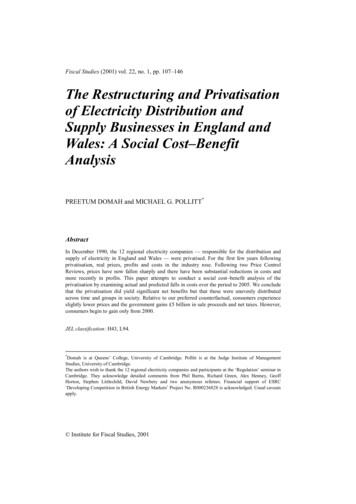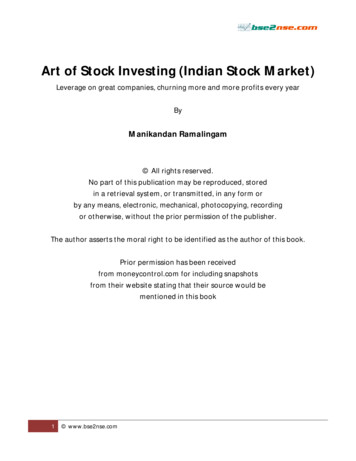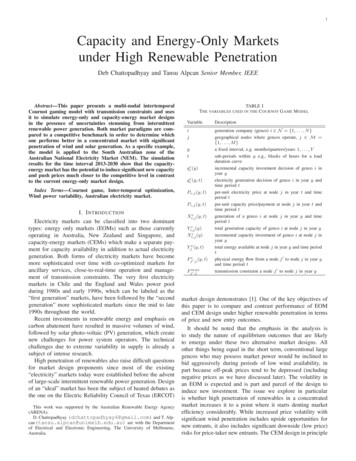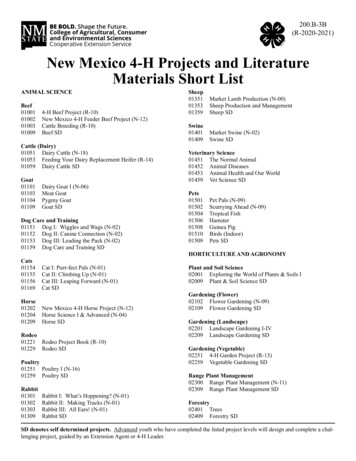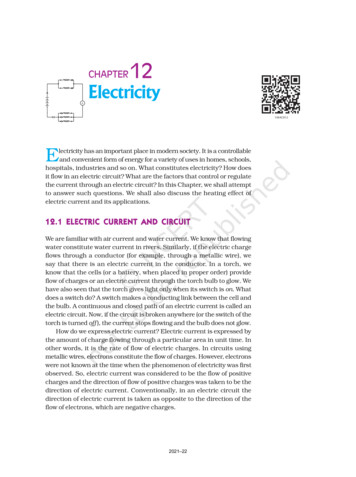
Transcription
ELECTRICITYMARKETS& POLICYELECTRICITYMARKETS& POLICYFuture of Energy Efficiency in Buildings:Drivers and Market ExpectationsE NERGY T ECHNOLOGIES A REA E NERGY A NALYSIS AND E NVIRONM ENTAL I M PACTS D IVISION E LECTRICITY M ARKETS & P OLICY
ELECTRICITYMARKETS& POLICYELECTRICITYMARKETS& POLICYFuture of Energy Efficiency in Buildings:Drivers and Market ExpectationsPresentation By:Steve Schiller, Affiliate and Senior AdvisorElectricity Markets and Policy Department, Lawrence Berkeley National LaboratoryJune 30, 2022E NERGY T ECHNOLOGIES A REA E NERGY A NALYSIS AND E NVIRONM ENTAL I M PACTS D IVISION E LECTRICITY M ARKETS & P OLICY
Berkeley Lab – Electricity Markets and Policy DepartmentInforming public and private decision-making through through independent,interdisciplinary analysis of critical electricity policy and market issuesTechnical Assistance to State, Local, and Tribal Governments With funding from the U.S. Department of Energy, the Berkeley Labprovides provides technical and policy support to public regulatorycommissions and energy offices on a wide range of topics.For more information, contact: Natalie Frick: nfrick@lbl.gov Pete Cappers: pacappers@lbl.gov Lisa Schwartz: lcschwartz@lbl.govAcknowledgementsThis work was funded by the U.S. Department of Energy’s BuildingTechnologies Office, under Contract No. DE-AC02-05CH11231.We would like to especially thank DOE’s David Nemtzow and MonicaNeukomm for their support of this work.And the reports co-authors: Jeff Deason, Kelly Parmenter, Greg Leventisand Lisa SchwartzDisclaimer/CopyrightDisclaimerThis document was prepared as an account of work sponsored by theUnited States Government. While this document is believed to containcorrect information, neither the United States Government nor anyagency thereof, nor The Regents of the University of California, nor anyof their employees, makes any warranty, express or implied, or assumesany legal responsibility for the accuracy, completeness, or usefulness ofany information, apparatus, product, or process disclosed, or representsthat its use would not infringe privately owned rights. Reference herein toany specific commercial product, process, or service by its trade name,trademark, manufacturer, or otherwise, does not necessarily constitute orimply its endorsement, recommendation, or favoring by the United StatesGovernment or any agency thereof, or The Regents of the University ofCalifornia. The views and opinions of authors expressed herein do notnecessarily state or reflect those of the United States Government or anyagency thereof, or The Regents of the University of California.Ernest Orlando Lawrence Berkeley National Laboratory is an equalopportunity employer.Copyright NoticeThis manuscript has been authored by an author at Lawrence BerkeleyNational Laboratory under Contract No. DE-AC02-05CH11231 with theU.S. Department of Energy. The U.S. Government retains, and thepublisher, by accepting the article for publication, acknowledges, that theU.S. Government retains a non-exclusive, paid-up, irrevocable,worldwide license to publish or reproduce the published form of thismanuscript, or allow others to do so, for U.S. Government purposesWe also thank our interviewees and questionnaire respondents and E9Insight for their research assistance.E NERGY T ECHNOLOGIES A REA E NERGY A NALYSIS AND E NVIRONM ENTAL I M PACTS D IVISION E LECTRICITY M ARKETS & P OLICY2
Topics for Todays Webinar Project Scope and Approach Drivers of Energy Efficiency in Buildings Energy Efficiency in Buildings: FutureExpectations Implications and Use of This ResearchE NERGY T ECHNOLOGIES A REA E NERGY A NALYSIS AND E NVIRONM ENTAL I M PACTS D IVISION E LECTRICITY M ARKETS & P OLICY3
Project Scope and ApproachScopeApproach Identify and describe drivers that have the potentialto define the future of energy efficiency markets forU.S. buildings over the next decade Provide heuristic descriptions of possible futureattributes of efficiency markets No specific predictions of the future, such as whatwill be the newest and best technologies orbusiness modelsE NERGY T ECHNOLOGIES A REA Review of recentdemand-side managementactions in twelve statesLiterature reviewInterviews of 21 experts in efficiency andenergy markets from industry, utilities,research groups and academiaQuestionnaire completed by 41 efficiencypractitionersReview and analysis of collected informationE NERGY A NALYSIS AND E NVIRONM ENTAL I M PACTS D IVISION E LECTRICITY M ARKETS & P OLICY4
Why This Work Is ImportantUnderstanding Drivers Understanding efficiency market drivers andpossible future efficiency market attributes canhelp policy makers, regulators, gov’t officials,U.S. consumers spend over 400 billion eachutilities and the efficiency industry makeyear to energize homes and commercialinformed decisionsbuildings that account for 39% of the nation'senergy use, 3/4 of electricity consumption For example, how best to design policies andand account for 35% of U.S. CO2 emissions.investments to support essential outcomes.Much of this money and energy is wasted.Buildings Energy Use is a major part ofUS energy economy & emissions The energy efficiency market that addressesthis waste supports some 2 million jobsacross the country.E NERGY T ECHNOLOGIES A REA E NERGY A NALYSIS AND E NVIRONM ENTAL I M PACTS D IVISION E LECTRICITY M ARKETS & P OLICY5
Six Identified Drivers of Energy Efficiency in BuildingsWe identified six categories of interrelated and overlapping drivers(determinants) that influence the attributes of energy efficiency markets.E NERGY T ECHNOLOGIES A REA E NERGY A NALYSIS AND E NVIRONM ENTAL I M PACTS D IVISION E LECTRICITY M ARKETS & P OLICY6
Two Major Driver Categories: Policy and Energy Costs1. Public Policy and Regulation Federal, regional, state, and local policies andregulation— examples: GHG policies, building energycodes, appliance standards, efficiency incentives ormandates, and performance-based ratemaking Literature review, interviews and questionnaires shownear-universal agreement that energy and climatepolicies and regulations have and will continue to be themost important driver of efficiency investments.80%Questionnaire responses: Government energyand climate policies and regulations will be one ofthe most important drivers of efficiency markets.60% Cost of energy and the dost of implementingenergy efficiency for reducing the energy costburden of buildings Basic economics matter. Higher energy prices(more expensive energy bills) lead to reducedconsumption, potentially in part due to efficiencyactions. However, direct consumer non-energy benefits,NEBs, continue to rise in importance.60%40%40%Questionnaire responses: The cost ofenergy to consumers will be one of themost important drivers of efficiencymarkets.20%20%0%2. Energy Costs0%Strongly agreeAgreeDisagree Strongly disagree No opinionE NERGY T ECHNOLOGIES A REA StronglyagreeE NERGY A NALYSIS AND E NVIRONM ENTAL I M PACTS D IVISIONAgree DisagreeStronglydisagreeE LECTRICITY M ARKETS & P OLICYNo opinion7
Four Other Important Drivers: Technology Advances, EconomicConditions, Social Priorities, Business Practices3. Technology Advances – Incremental anddisruptive technology change, including: Technologies intrinsic to efficiency—examples: efficient motors, LEDs, controlsystems, and commissioning Technologies extrinsic to efficiency—examples: data access and data science,universal internet access, renewable energyresources, and energy storage4. Economic Conditions5. Societal Priorities – Societal practices and normsand valuation of efficiency energy and non-energybenefits for society as a whole and individuals examples: increasing use of air conditioning andinterest in ESG priorities6. Business Practices – Means for providing andmaintaining products and services and providinginformation - examples: performance contracting,utility business models, market consolidation,behavior-based programs, and workforce resourcesand training. Status of the U.S. economy Demographic changesE NERGY T ECHNOLOGIES A REA E NERGY A NALYSIS AND E NVIRONM ENTAL I M PACTS D IVISION E LECTRICITY M ARKETS & P OLICY8
The Efficiency Market: Future Expectations“It's tough to make predictions, especially about the future.” Danish ProverbBottom Line: Overarching expectations for energyefficiency in buildings:Based on concepts and expectationsdeduced from this project’s research,we developed: Two potential scenarios thatsummarize the market expectationsfound via our research Some specific expectations Some specific unknowns No singular future. Attributes will vary by market sector,jurisdiction and geography. Attributes defined by: Overall, state and local governments will increase theirefficiency achievements: E NERGY T ECHNOLOGIES A REA The six categories of interrelated and overlapping driversDivergent characteristics of each market sector, e.g., residential,low-income, commercial, urban, ruralLow-to-moderate national growth in efficiency-based energysavings unlessPublic policy mandates ramp up requirements, particularly withrespect to GHG emission reductions---- yielding moderate-to-highgrowth for efficiency-based impacts.E NERGY A NALYSIS AND E NVIRONM ENTAL I M PACTS D IVISION E LECTRICITY M ARKETS & P OLICY9
Additional Expectations for Future of Energy Efficiency in Buildings Efficiency investments will continue to consist of amix of incentive-supported actions, adoption drivenby codes and standards, and routine marketadoption. Electricity efficiency actions will become morefocused on demand flexibility and time andlocational value of energy use Efficiency improvements in some technologies willresult in greater impacts—for example, heat pumpsfor space and water heating, building energycontrols, and building shell components However, for some end-uses and technologies (e.g.,lighting, motors and boilers), we will not seeefficiency advances at the rate they have occurredin the past given existing high efficiency levelsE NERGY T ECHNOLOGIES A REA Technological advances that support efficiency, suchas in interoperability , AI, and universal internetaccess, will improve the efficacy of efficiency Efficiency marketing will increasingly focus on: Grid services and demand flexibility Building decarbonization Efficiency’s non-energy benefits Efficiency in a package of other DERs Low-income programs will see increased investmentwith a focus on energy-burdened communities andhouseholds. These programs will increasinglyemphasize social benefits of reducing energy bills,the value of improving health, safety and comfort,and the importance of addressing historicdiscrimination and lack of attention to suchcommunities.E NERGY A NALYSIS AND E NVIRONM ENTAL I M PACTS D IVISION E LECTRICITY M ARKETS & P OLICY10
Discussion – Some Unknowns for the Future of Energy Efficiency Will there be a greater emphasis on deep, comprehensiveefficiency retrofits? Or will the emphasis be on morefocused retrofits of just the high value component/systemefficiency opportunities,How will the role of utilities change with respect toadministering and implementing efficiency actions? Will there be further consolidation among companiesoffering efficiency services and products?Will governments and utilities actively encourageconsumers to shift from using natural gas in buildings infavor of non-fossil fuel based technologies?What black swans will impact building efficiency? Changing perception of the role of government indirecting energy markets through efficiency and otherenergy or environmental mandates Supply chain issues (including severe energy shortages)that are human-caused or naturalWill existing constraints in the availability of skilled energyefficiency workers, and workers in related fields, limit thefuture success of energy efficiency markets?E NERGY T ECHNOLOGIES A REA E NERGY A NALYSIS AND E NVIRONM ENTAL I M PACTS D IVISION E LECTRICITY M ARKETS & P OLICY11
Implications and Applications of this ReportUsing This Research to Support Efficiency’sPreferred FutureImplications for the Future of Efficiency Over the next decade, as in the last 50 years, buildingefficiency markets will likely see significant swings ininvestment and uncertainty.The rate of progress toward building decarbonization andgrid integration of renewables will significantly impact thepace of efficiency actions.Achieving large efficiency impacts requires supportivepolicies and regulations, as well as their effectiveimplementation. Thus, meaningful stakeholder engagementis critical both for development and implementation ofeffective policies and regulations.As energy transitions occur, increased support is neededfor those with the heaviest energy burdens, and the fewestresources to address them, through public and ratepayerefficiency investments.E NERGY T ECHNOLOGIES A REA Among the areas to focus support on are benefits of andopportunities for: Technical assistance for local, state, regional and federaldecision makersIntrinsic and extrinsic (to efficiency) technologicaldevelopments Building decarbonization strategies Tariff designs Market transformation, including via, for example, buildingenergy disclosure and benchmarkingInnovative business practice experimentation, includingdemand flexibility and DER integration, system/communityapproaches, and financing optionsLabor force developmentE NERGY A NALYSIS AND E NVIRONM ENTAL I M PACTS D IVISION E LECTRICITY M ARKETS & P OLICY12
ELECTRICITYMARKETS& POLICY IN BUILDINGSFUTUREOF ENERGYEFFICIENCYContactsSteve Schiller, srschiller@lbl.govLisa Schwartz, lcschwartz@lbl.govJeff Deason, jadeason@lbl.govThank YouFull report available at:For more information on Electricity Markets and Policy:https://emp.lbl.gov/Download our cybuildingsSign up for our email list: https://emp.lbl.gov/mailing-listFollow us on Twitter: @BerkeleyLabEMPE NERGY T ECHNOLOGIES A REA E NERGY A NALYSIS AND E NVIRONM ENTAL I M PACTS D IVISION E LECTRICITY M ARKETS & P OLICY13
ELECTRICITYMARKETS& POLICY IN BUILDINGSFUTUREOF ENERGYEFFICIENCYOur Panelists: Jennifer Chamberlin, Executive Director, Market Development at CPower Andrew deLaski, Executive Director, Appliance Standards AwarenessProject Chandra Farley, CEO, ReSolve Megan Gilman, Commissioner, Colorado Public Utilities Commission David Nemtzow, Senior Advisor for the U.S. Department of Energy's LoanPrograms Office Mary Ann Piette, Director, Berkeley Lab Building Technology and UrbanSystems Division Kenneth Shiver, Chief Economist, Director of Planning, Regulatory &Strategy Support at Southern Company And our question moderator: Jeff Deason, Program Manager, BerkeleyLab Electricity Markets and Policy DepartmentE NERGY T ECHNOLOGIES A REA E NERGY A NALYSIS AND E NVIRONM ENTAL I M PACTS D IVISION E LECTRICITY M ARKETS & P OLICY14
However, direct consumer non-energy benefits, NEBs, continue to rise in importance. Strongly agree. Agree. Disagree. Strongly disagree. No opinion. 0%. 20%. 40%. 60%. 80%. Questionnaire responses: Government energy and climate policies and regulations will be one of the most important drivers of efficiency markets. Strongly agree. Agree .



